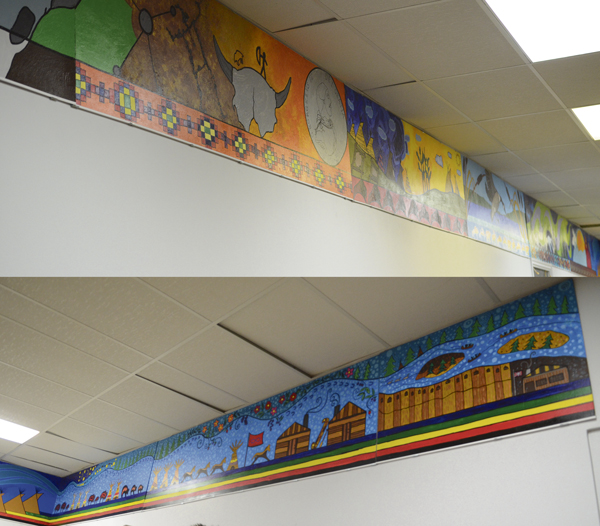
Artists Kevin Pee-Ace and Leah Dorion took the time to walk through their mural panels and talk about the designs they chose and their significance in terms of telling the stories of the area’s Indigenous peoples. Here’s what they had to say:
Kevin Pee-Ace
Pee-Ace was responsible for designing and overseeing the painting of six panels depicting the histories of the area’s First Nations.
Five of the panels portray elements of a specific group’s historical culture, while the first panel uses petroglyphs and images of buffalo skulls and arrowheads to depict the region’s First Nations as a whole, pre-contact with European settlers.
The second panel is designed to pay tribute to the Dakota. It uses elements of their designs, like beadwork, as well as a portrayal of the King George III Medal awarded for the group’s contributions during the war of 1812. It also shows rock formations, including one that depicts seasons of the year, and another that shows a trickster figure. It also includes some petroglyphs, flowing from the first panel to the second.
The third panel shows the Plains Cree. It was painted with the help of students from Queen Mary school and shows teepees, buffalo, the main traditional staple for the Plains Cree, and the contrast between night and day.
The fourth panel is dedicated to swampy Cree. It features several animals, which are important to them for food and for learning about different aspects of the world, Pee Ave said. It also prominently features a goose.
The fifth panel, also painted with assistance from Queen Mary students, shows the woodlands panel. It includes depictions of animals such as caribou, elk, rabbit and geese, trees and the northern lights.
“When you’re up north, there’s this sense of what the animals are there for too,” Pee Ace said.
“If you want to survive, that’s how you’re going to do it. That’s what (the animals) are there for. Survival.”
Pee Ace also included some of his own, traditional artwork designs in the panel.
The sixth panel depicts the Dene people. It prominently features a barren ground caribou, which remains an important animal for Dene people. It also includes the northern lights, tying it in with the fifth panel.
One of the most prominent features of the Dene panel is the depiction of Thanadelthur, a Dene-speaking woman and First Nations heroine who helped broker a peace deal between the Cree and Dene. Pee Ace heard her story while visiting Wollaston Lake for an unrelated project. He said people he spoke with described her as a key figure in their history.
Leah Dorion
Leah Dorion took a slightly different approach, using multiple panels along the top of one wall to tell a single story of the history of the Métis. She also led the production of two other panels, which hang elsewhere in the exhibit.
The multi-panel, long, continuous piece honours the river highway.
“There is so much use of the river, not just by humans but by keystone species, like the buffalo and the bear.”
The panels trace the history of the people from living in teepees to the riverbank settlements and a Hudson Bay Trading Post. The mural’s bottom border is painted in solid stripes lasting the length of the work. Those colours represent the colours of the sash, the Hudson Bay Blanket and the First nations Medicine Wheel, as well as the blue for the river.
“I picked those colours because they had multiple symbols of what makeup Métis people because of our roots,” Dorion explained.
The second mural shows the harvesting of resources by Metis people of the region up to the Red Deer Hill area. Dorion said Red Deer Hill was a landmark between the English Métis of Prince Albert and the French Métis of Batoche.
“It was a great place of meeting in the Prince Albert, Kistapinanihk region for us people in the English Metis and French Métis community.”
The third mural again focuses on the river and its role in providing trade and transport for the Métis while also drawing buffalo to winter and access water. It’s also filled with symbolism, from the Métis sash border to use of beadwork designs on the edge of the image.
All three pieces include nods to the English Metis, who were known historically as half-breeds. Those nods include the red, Scottish Metis flag, as opposed to the blue French Métis flag.
“In the time of early P.A., it was more of an English Metis settlement,” Dorion said. “I wanted to give them the recognition and acknowledgement.”
Since then, it has changed, with many French Métis families migrating into the area, Dorion explained.
Overall, she’s extremely pleased with how all the murals came together.
“ love them on the wall, and I love how they’re mounted high,” she said.
‘When you enter the room, you scan high and then your eye comes to the floor. It changes how we engage with the room. It adds colour to the artifacts that are very old and in different earth tones.
“It brings people to life. These are people’s artifacts too, but the people aren’t here. We put that energy into them with life.”

